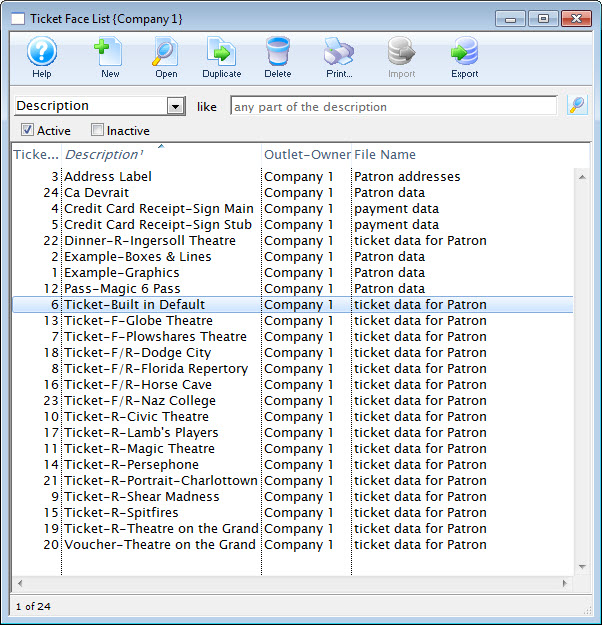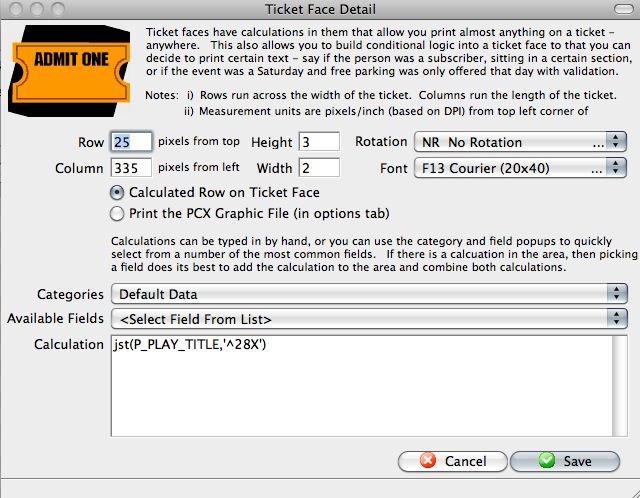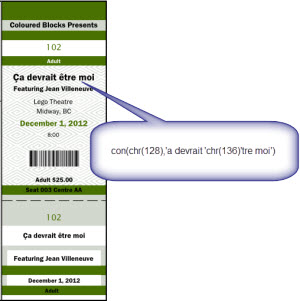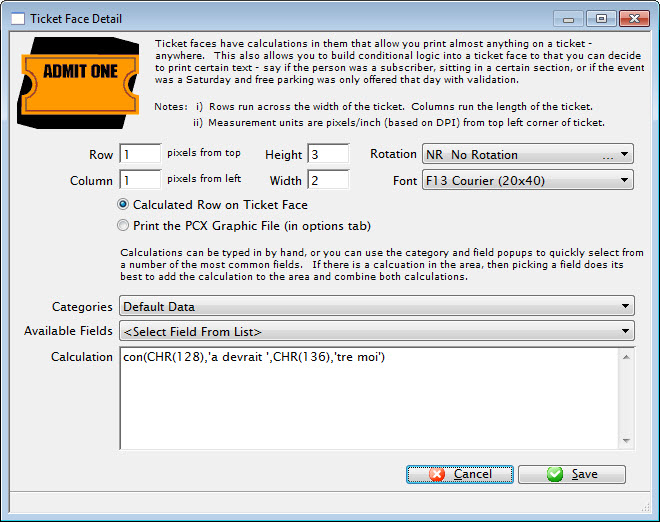Adding Accented Letters to a Ticket Face
 |
Printing accented letters on tickets limits you to using Font F13.
This means for any field that has an accented letter within it, the line must use font F13 (other lines of coding can be any other font you wish). This is the only available font within the default language for the ticket printer that uses the extended ASCII character set. Click here to download a table of Font 13 codes or refer to the table at the bottom of this help page. |
Why don't thermal printers support accents in all fonts?
Automatic printing of French or other European characters is not easily done using ticket printers. To understand why, is a bit of a trip through computer history. ASCII (American Standard Code for Information Interchange) is a character encoding system based on the English Alphabet. ASCII codes represent text in computers, communications equipment, printers and any other device that uses text. ASCII first came from telegraphic codes. Its first commercial application was a code for teleprinters. It began in the 1960s and the last update to the character set was in 1986. It was the standard world wide until 2008 when it was surpassed by UTF-8.
As computer technology spread, the ASCII character set spread with it and the Europeans decided to get creative and put some accented characters in some of the empty slots in the character set -- where these characters was not standardized into the exteneded ASCII set until the 1970's. Because of this the characters are non-standard and their placement in the listing in irregular.
Because this was a large problem, they invented UTF-8 (about 1992 http://en.wikipedia.org/wiki/UTF-8) , the universal character set. UTF 8 is designed to hold 2 billion plus character combinations, including the entire Chinese character set. All new computers, realizing that foreign language is a benefit, support this. Theatre Manager is fully UTF8 -- you can put accented characters into the database. You can print them on reports. You can add them to emails. all those products also understand UTF8 so characters are no issue.
Unfortunately, it is not the same for the ticket printers. Ticket printers do not understand UTF 8. They are limited to ASCII and a few variations. The only font supplied with the printers is the extended ASCII set in Font 13. Click here to access the Practical Automation Printer manual.
How to use FONT 13 to get accented characters
In some instances, a Play or Event title or other piece of information you need to print on a ticket face, includes an accented letter. The following instructions will allow you to make that edit.
- Chose Setup --> Ticket Faces to open the Ticket Face List Window.

For more information on the click here.
- Create a new ticket face, or a duplicate of an exiting ticket face.
This will allow you to continue using the original ticket face for your events that do not require any accented characters. For more information on designing ticket faces, please click here.
- Double-click the line of ticket face code to edit to include the accented text.
This opens the Ticket Face Detail window for that line of code.

For information about formatting ticket faces, click here.
- Select Font F13 from the Font Drop Down Menu.
 .
.

Selection of any font, other than F13, will print "?" for the character. Any other fonts available do not reference the extended ASCII character set.
- Enter the Code con(chr(128),'a devrait 'chr(136)'tre moi')
To add the title:Ça devrait être moi

In order to have accented characters appear on a ticket face, you will need to HARD CODE the accent onto the ticket face. For Example, to have Théatre appear on a ticket face,
Click here to download a table of Font 13 codes.

Font 13 Characters and Numbers
Click here to download a table of Font 13 codes.
| Dec | Char | Description | Dec | Char | Description |
| 128 |
Ç | Latin upper case C with cedilla | 192 | Graphic Character | |
| 129 |
ü | Latin lower case u with diaeresis | 193 | " | |
| 130 |
é | Latin lower case e with acute | 194 | " | |
| 131 |
â | Latin lower case a with circumflex | 195 | " | |
| 132 |
ä | Latin upper case A with circumflex | 196 | " | |
| 133 |
à | Latin lower case a with grave | 197 | " | |
| 134 |
å | Pilcrow sign | 198 |
ã | Latin lower case a with tilde |
| 135 |
ç | Latin lower case c with cedilla | 199 |
à | Latin upper case A with tilde |
| 136 |
ê | Latin lower case e with circumflex | 200 | Graphic Character | |
| 137 |
ë | Latin lower case e with umlaut | 201 | " | |
| 138 |
è | Latin lower case e with grave | 202 | " | |
| 139 |
ï | Latin lower case i with umlaut | 203 | " | |
| 140 |
î | Latin lower case i with circumflex | 204 | " | |
| 141 |
ì | Double low line | 205 | " | |
| 142 |
Ä | Latin upper case A with grave | 206 | " | |
| 143 |
Å | Section sign | 207 | " | |
| 144 |
É | Latin upper case E with acute | 208 |
ð | Latin lowercase eth |
| 145 |
æ | ligature | 209 |
Ð | Latin uppercase Eth |
| 146 |
Æ | Latin upper ligature | 210 |
Ê | Latin upper case E with circumflex |
| 147 |
ô | Latin lower case o with circumflex | 211 |
Ë | Latin upper case E with umlat |
| 148 |
ö | Latin lower case o with umlaut | 212 |
È | Latin upper case E with accent |
| 149 |
ò | Latin lower case o with grave | 213 | Latin lower case dotless i | |
| 150 |
û | Latin lower case u with circumflex | 214 |
Í | Latin upper case I with accent |
| 151 |
ù | Latin lower case u with grave | 215 |
Î | Latin upper case I with circumflex |
| 152 |
ÿ | Latin lower case y with umlaut | 216 |
Ï | Latin upper case I with umlaut |
| 153 |
Ö | Latin upper case O with umlaut | 217 | Graphic Caracter | |
| 154 |
Ü | Latin upper case U with umlaut | 218 | " | |
| 155 |
ø | Small slashed zero | 219 | " | |
| 156 |
£ | Pound Sign | 220 | " | |
| 157 | Ø | Large slashed zero | 221 | " | |
| 158 |
x | Times | 222 |
Ì | Latin upper case I with grave |
| 159 |
ƒ | Latin lower case f with hook | 223 | Graphic Character | |
| 160 |
á | Latin lower case a with acute | 224 |
Ó | Latin upper case O with accent |
| 161 |
í | Latin lower case i with acute | 225 |
ß | Eszett or Sharp S |
| 162 |
ó | Latin lower case o with acute | 226 |
Ô | Latin upper case O with circumflex |
| 163 |
ú | Latin lower case u with acute | 227 |
Ò | Latin upper case O with grave |
| 164 |
ñ | Latin lower case n with tilde | 228 |
õ | Latin lower case O with tilde |
| 165 |
Ñ | Latin upper case N with tilde | 229 |
Õ | Latin upper case O with tilde |
| 166 | ª | feminine ordinal indicator | 230 |
µ | Micro sign |
| 167 |
º | Degree Symbol | 231 |
þ | Lower case letter Thorn |
| 168 |
¿ | Inverted Question Mark | 232 |
Þ | Upper case letter Thorn |
| 169 | ® | Registered Trade Mark - note it is not the 'tm' symbol | 233 |
Ú | Latin upper case U with acute |
| 170 |
¬ | Not sign | 234 |
Û | Latin upper case U with circumflex |
| 171 |
½ | Fraction one half | 235 |
Ù | Latin upper case U with grave |
| 172 |
¼ | Fraction one quarter | 236 |
ý | Latin lower case y with acute |
| 173 |
¡ | Reversed Exclamation Mark | 237 |
Ý | Latin upper case Y with acute |
| 174 |
« | Left-pointing double angle quotation mark | 238 | Graphic character | |
| 175 |
» | Right-pointing double angle quotation mark | 239 | " | |
| 176 |
| Graphic character | 240 | " | |
| 177 | " | 241 | " | ||
| 178 |
| " | 242 | " | |
| 179 | " | 243 | " | ||
| 180 | " | 244 | " | ||
| 181 |
Á | Latin upper case A with acute | 245 | " | |
| 182 |
Â
| Latin upper case A with circumflex | 246 | " | |
| 183 |
À | Latin upper case A with grave | 247 | " | |
| 184 | © | Copyright | 248 | " | |
| 185 |
| Graphic Character | 249 | " | |
| 186 | " | 250 | " | ||
| 187 |
| " | 251 | " | |
| 188 | " | 252 | |||
| 189 |
¢ | Cent Sign | 253 | " | |
| 190 |
¥ | Yen | 254 | " | |
| 191 | Graphic Character | 255 | " |